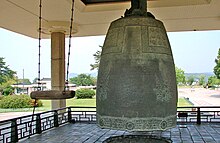35°49′46.47″N 129°13′40.54″E / 35.8295750°N 129.2279278°E
| Bell of King Seongdeok | |
 National Treasure of Korea No.29: The Bell of King Seongdeok. | |
| Korean name | |
|---|---|
| Hangul | 성덕대왕신종 |
| Hanja | 聖德大王神鍾 |
| Revised Romanization | Seongdeok Daewang Sinjong |
| McCune–Reischauer | Sŏngdŏk Taewang Sinjong |
| Other name | |
| Hangul | 에밀레종 |
| Hanja | 에밀레鍾 |
| Revised Romanization | Emille Jong |
| McCune–Reischauer | Emille Chong |
The Bell of King Seongdeok (Korean: 성덕대왕신종) is a large bronze bell, the largest extant bell in Korea. The full Korean name means "Sacred (or Divine) Bell of King Seongdeok the Great." It was also known as the Emille Bell (에밀레종), after a legend about its casting, and as the Bell of Bongdeoksa Temple, where it was first housed.
The bell was commissioned by King Gyeongdeok to honor his father, King Seongdeok. However, King Gyeongdeok never lived to see the casting of the bell, as he died in 765 A.D. The bell was finally cast in 771 A.D., during the reign of Gyeongdeok's son, King Hyegong.
Now housed in the Gyeongju National Museum, the bell was designated as the 29th national treasure of Korea on December 12, 1962. It measures 3.75 meters (12.3 ft) high, 2.27 meters (7.4 ft) in diameter at the lip, and 12 to 25 centimeters (4.7 to 9.8 in) in wall thickness. The Gyeongju National Museum weighed it in 1997, and found that its weight was 18.9 tons.[1]
- ^ Korea Tourism Organization. "The Divine Bell of King Seongdeok". Visit Korea. Archived from the original on 2012-03-05. Retrieved 2021-03-28.